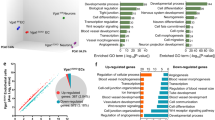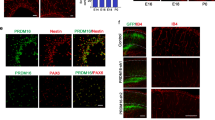Abstract
Prevailing notions of cerebral vascularization imply that blood vessels sprout passively into the brain parenchyma from pial vascular plexuses to meet metabolic needs of growing neuronal populations. Endothelial cells, building blocks of blood vessels, are thought to be homogeneous in the brain with respect to their origins, gene expression patterns and developmental mechanisms. These current notions that cerebral angiogenesis is regulated by local environmental signals contrast with current models of cell-autonomous regulation of neuronal development. Here we demonstrate that telencephalic angiogenesis in mice progresses in an orderly, ventral-to-dorsal gradient regulated by compartment-specific homeobox transcription factors. Our data offer new perspectives on intrinsic regulation of angiogenesis in the embryonic telencephalon, call for a revision of the current models of telencephalic angiogenesis and support novel roles for endothelial cells in brain development.
This is a preview of subscription content, access via your institution
Access options
Subscribe to this journal
Receive 12 print issues and online access
$209.00 per year
only $17.42 per issue
Buy this article
- Purchase on Springer Link
- Instant access to full article PDF
Prices may be subject to local taxes which are calculated during checkout








Similar content being viewed by others
References
Risau, W. Mechanisms of angiogenesis. Nature 386, 671–674 (1997).
Kurz, H. Physiology of angiogenesis. J. Neurooncol. 50, 17–35 (2000).
Strong, L.H. The early embryonic pattern of internal vascularization of the mammalian cerebral cortex. J. Comp. Neurol. 123, 121–138 (1964).
Carmeliet, P. & Tessier-Lavigne, M. Common mechanisms of nerve and blood vessel wiring. Nature 436, 193–200 (2005).
Hogan, K.A., Ambler, C.A., Chapman, D.L. & Bautch, V.L. The neural tube patterns vessels developmentally using the VEGF signaling pathway. Development 131, 1503–1513 (2004).
Keynes, R. & Lumsden, A. Segmentation and the origin of regional diversity in the vertebrate nervous system. Neuron 4, 1–9 (1990).
Puelles, L. & Rubenstein, J.L.R. Expression patterns of homeobox and other putative regulatory genes in the embryonic mouse forebrain suggests a neuromeric organization. Trends Neurosci. 16, 472–479 (1993).
Keynes, R.J. & Stern, C.D. Mechanisms of vertebrate segmentation. Development 103, 413–429 (1988).
Plate, K.H. Mechanisms of angiogenesis in the brain. J. Neuropathol. Exp. Neurol. 58, 313–320 (1999).
Greenberg, D.A. & Jin, K. From angiogenesis to neuropathology. Nature 438, 954–959 (2005).
Hiruma, T., Nakajima, Y. & Nakamura, H. Development of pharyngeal arch arteries in early mouse embryo. J. Anat 201, 15–29 (2002).
Sussel, L., Marin, O., Kimura, S. & Rubenstein, J.L. Loss of Nkx2.1 homeobox gene function results in a ventral to dorsal molecular respecification within the basal telencephalon: evidence for a transformation of the pallidum into the striatum. Development 126, 3359–3370 (1999).
Supèr, H., Martínez, A. & Soriano, E. Degeneration of Cajal-Retzius cells in the developing cerebral cortex of the mouse after ablation of meningeal cells by 6-hydroxydopamine. Devel. Brain Res. 98, 15–20 (1997).
Bayer, S.A. & Altman, J. Directions in neurogenetic gradients and patterns of anatomical connections in the telencephalon. Prog. Neurobiol. 29, 57–106 (1987).
Bayer, S.A. & Altman, J. Neocortical Development (Raven Press, New York, 1991).
Takahashi, T., Nowakowski, R.S. & Caviness, V.S., Jr . The leaving or Q fraction of the murine cerebral proliferative epithelium: a general model of neocortical neuronogenesis. J. Neurosci. 16, 6183–6196 (1996).
Takahashi, T., Goto, T., Miyama, S., Nowakowski, R.S. & Caviness, V.S., Jr . Sequence of neuron origin and neocortical laminar fate: relation to cell cycle of origin in the developing murine cerebral wall. J. Neurosci. 19, 10357–10371 (1999).
Anderson, S.A., Eisenstat, D.D., Shi, L. & Rubenstein, J.L.R. Interneuron migration from basal forebrain to neocortex: dependence on Dlx genes. Science 278, 474–476 (1997).
De Carlos, J.A., López-Mascaraque, L. & Valverde, F. Dynamics of cell migration from the lateral ganglionic eminence in the rat. J. Neurosci. 16, 6146–6156 (1996).
Rubenstein, J.L. et al. Genetic control of cortical regionalization and connectivity. Cereb. Cortex 9, 524–532 (1999).
Anderson, S., Mione, M., Yun, K. & Rubenstein, J.L.R. Differential origins of neocortical projection and local circuit neurons: role of Dlx genes in neocortical interneuronogenesis. Cereb. Cortex 9, 646–654 (1999).
Eisenstat, D.D. et al. DLX-1, DLX-2, and DLX-5 expression define distinct stages of basal forebrain differentiation. J. Comp. Neurol. 414, 217–237 (1999).
Puelles, L. & Rubenstein, J.L. Forebrain gene expression domains and the evolving prosomeric model. Trends Neurosci. 26, 469–476 (2003).
Stoykova, A., Fritsch, R., Walther, C. & Gruss, P. Forebrain patterning defects in Small eye mutant mice. Development 122, 3453–3465 (1996).
Stoykova, A., Treichel, D., Hallonet, M. & Gruss, P. Pax6 modulates the dorsoventral patterning of the mammalian telencephalon. J. Neurosci. 20, 8042–8050 (2000).
Hill, R.E. et al. Mouse Small eye results from mutations in a paired-like homeobox-containing gene. Nature 354, 522–525 (1991).
Schedl, A. et al. Influence of PAX6 gene dosage on development: overexpression causes severe eye abnormalities. Cell 86, 71–82 (1996).
Fishell, G., Mason, C.A. & Hatten, M.E. Dispersion of neural progenitors within the germinal zones of the forebrain. Nature 362, 636–638 (1993).
Ghanem, N. et al. Distinct cis-regulatory elements from the Dlx1/Dlx2 locus mark different progenitor cell populations in the ganglionic eminences and different subtypes of adult cortical interneurons. J. Neurosci. 27, 5012–5022 (2007).
Nery, S., Corbin, J.G. & Fishell, G. Dlx2 progenitor migration in wild type and Nkx2.1 mutant telencephalon. Cereb. Cortex 13, 895–903 (2003).
Marin, O., Anderson, S.A. & Rubenstein, J.L. Origin and molecular specification of striatal interneurons. J. Neurosci. 20, 6063–6076 (2000).
Caviness, V.S., Jr . Neocortical histogenesis in normal and reeler mice: a developmental study based upon (3H) thymidine autoradiography. Devel. Brain Res. 4, 293–302 (1982).
Rakic, P. & Caviness, V.S., Jr . Cortical development: view from neurological mutants two decades later. Neuron 14, 1101–1104 (1995).
Breier, G., Albrecht, U., Sterrer, S. & Risau, W. Expression of vascular endothelial growth factor during embryonic angiogenesis and endothelial cell differentiation. Development 114, 521–532 (1992).
Ericson, J. et al. Sonic hedgehog induces the differentiation of ventral forebrain neurons: a common signal for ventral patterning within the neural tube. Cell 81, 747–756 (1995).
Shimamura, K., Martinez, S., Puelles, L. & Rubenstein, J.L.R. Patterns of gene expression in the neural plate and neural tube subdivide the embryonic forebrain into transverse and longitudinal domains. Dev. Neurosci. 19, 88–96 (1997).
Cohen, M.M., Jr . Craniofacial anomalies: clinical and molecular perspectives. Ann. Acad. Med. Singapore 32, 244–251 (2003).
Yun, K. et al. Modulation of the notch signaling by Mash1 and Dlx1/2 regulates sequential specification and differentiation of progenitor cell types in the subcortical telencephalon. Development 129, 5029–5040 (2002).
Ambati, B.K. et al. Corneal avascularity is due to soluble VEGF receptor-1. Nature 443, 993–997 (2006).
Kusakabe, T. et al. Thyroid-specific enhancer-binding protein/NKX2.1 is required for the maintenance of ordered architecture and function of the differentiated thyroid. Mol. Endocrinol. 20, 1796–1809 (2006).
Yuan, B. et al. Inhibition of distal lung morphogenesis in Nkx2.1(−/−) embryos. Dev. Dyn. 217, 180–190 (2000).
Ben-Ari, Y., Khalilov, I., Represa, A. & Gozlan, H. Interneurons set the tune of developing networks. Trends Neurosci. 27, 422–427 (2004).
Rakic, P. Specification of cerebral cortical areas. Science 241, 170–176 (1988).
Gerfen, C.R. The neostriatal mosaic: striatal patch-matrix organization is related to cortical lamination. Science 246, 385–388 (1989).
Bhide, P.G. Cell cycle kinetics in the embryonic mouse corpus striatum. J. Comp. Neurol. 374, 506–522 (1996).
Sheth, A.N. & Bhide, P.G. Concurrent cellular output from two proliferative populations in the early embryonic mouse corpus striatum. J. Comp. Neurol. 383, 220–230 (1997).
Kimura, S. et al. The T/ebp null mouse: thyroid-specific enhancer-binding protein is essential for the organogenesis of the thyroid, lung, ventral forebrain, and pituitary. Genes Dev. 10, 60–69 (1996).
Motoike, T. et al. Universal GFP reporter for the study of vascular development. Genesis 28, 75–81 (2000).
Pfaffl, M.W. A new mathematical model for relative quantification in real-time RT-PCR. Nucleic Acids Res. 29, e45 (2001).
Acknowledgements
We thank S. Anderson (Weill-Cornell Medical College) for sharing with us the Nkx2.1+/− line. We gratefully acknowledge technical assistance by I. Bagayev (confocal microscope), L. Zagachin (real-time PCR) and M. Waring (FACS). This work was supported by RO1NS43246, RO1DA020796 and P30NS045776 to P.G.B.
Author information
Authors and Affiliations
Contributions
A.V. and P.G.B. designed the experiments and wrote the manuscript. A.V. conducted the experiments. J.E.L. and J.L.R.R. provided Dlx1/2 mutant and wild-type embryos; J.E.C. supplied reeler mutant and wild-type embryos and all three commented on earlier versions of the manuscript.
Corresponding authors
Supplementary information
Supplementary Text and Figures
Supplementary Figures 1–16 (PDF 673 kb)
Rights and permissions
About this article
Cite this article
Vasudevan, A., Long, J., Crandall, J. et al. Compartment-specific transcription factors orchestrate angiogenesis gradients in the embryonic brain. Nat Neurosci 11, 429–439 (2008). https://doi.org/10.1038/nn2074
Received:
Accepted:
Published:
Issue Date:
DOI: https://doi.org/10.1038/nn2074
This article is cited by
-
Foxp1 suppresses cortical angiogenesis and attenuates HIF-1alpha signaling to promote neural progenitor cell maintenance
EMBO Reports (2024)
-
Organization of self-advantageous niche by neural stem/progenitor cells during development via autocrine VEGF-A under hypoxia
Inflammation and Regeneration (2023)
-
Neurogenic–angiogenic synchrony via lactate
Nature Neuroscience (2022)
-
Human forebrain endothelial cell therapy for psychiatric disorders
Molecular Psychiatry (2021)
-
Hierarchical imaging and computational analysis of three-dimensional vascular network architecture in the entire postnatal and adult mouse brain
Nature Protocols (2021)



